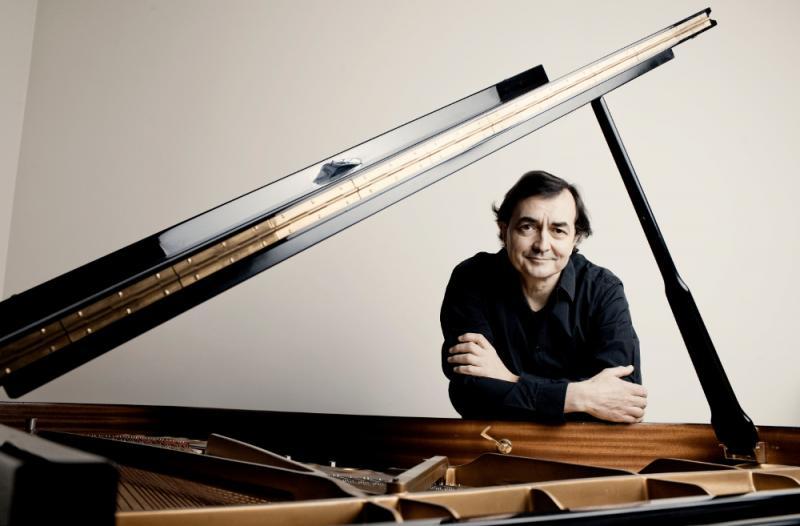Pierre-Laurent Aimard, QEH review – taking Ligeti to extremes | reviews, news & interviews
Pierre-Laurent Aimard, QEH review – taking Ligeti to extremes
Pierre-Laurent Aimard, QEH review – taking Ligeti to extremes
Long-standing advocate keeps Ligeti fresh and vibrant, and delivers plenty of surprises

After Pierre-Laurent Aimard’s first concert in his weekend Ligeti festival at the Southbank, an innovative programme spanning influential contemporaries and new arrangements, this second was a more canonical affair: the three books of Piano Études presented in recital.
The answer is: He continues to take risks, and to take the music to extremes. This is music that mixes order and chaos, and Aimard revels in the ambiguity, sliding into metric irregularity at the slightest opportunity. He also holds the composer to his extreme dynamic markings, the thundering climaxes to many of the movements well outside his physical comfort zone.
In a post-concert talk, with Gillian Moore, Aimard discussed how Ligeti uses illusions, particularly the illusion of regularity in irregular music. His performance of the First Étude, “Désordre”, was a case in point: For the first few bars, the short phrases seemed to maintain a strict and simple rhythm, but gradually the cracks started to emerge, the titular disorder revealed as Aimard progressively emphasised the disjointed and increasingly polyrhythmic structure.
The Études revolve around these technical and perceptual devices, but there is plenty of variety, especially in the First Book. In “Touches bloquées”, the left hand depresses keys silently, while the right plays runs in the same register, the depressed keys registering as gaps. But they are not silences, and, as Aimard convincingly demonstrated, the rhythm is carried by the sound of the fingers striking the depressed keys. And there was subtlety too: “Fanfares” employs legato runs in the left hand (irregularly subdivided, of course) to accompany the emphatic right hand melody. The deftness of Aimard’s touch here was perfect, and combined with virtuosic pedal work to delineate those irregular subdivisions. “Automne à Varsovie”, the grand, polymetric finale to the First Book, almost came a cropper due to a page-turning snafu, but Aimard recovered well to bring off a thundering conclusion.
Aimard wisely placed the four diminutive études of the unfinished Third Book between the First and Second. These are interesting works, but are more demure than their predecessors. This is music of old age, and fits uneasily into the continuous invention of the earlier works. But here in the middle, they acted as a kind of central slow movement – relatively slow at least. No 17, “À bout de soufflé” (Breathless), lived up to its title here.
In the Second Book, everything gets more complicated. Ligeti here goes further into ideas derived from fractal geometry, and these more complex ideas require longer works and more sophisticated structuring. But Aimard knows how to keep his listeners onboard, always delivering Ligeti’s conjuring tricks – the clocks that might be clouds, the clouds that might be clocks. Speaking of clouds, there was another spectacular page turning incident mid-way through, Aimard and his page turner engulfed in a flurry of loose pages as they were hurriedly swept from the stand. Aimard’s fault apparently – he had the pages in the wrong order.
From here, the final movements are a gradual progression from one level of unimaginable complexity to the next, and it is no coincidence that these include the two dedicated to Aimard himself. The hard, clean sound of Aimard’s Yamaha piano came into its own here, giving tonal definition and rhythmic attack. The final movement of the Second Book, “Coloana infinită”, like the final movement of the First, requires some real theatre from the pianist, but the gestures – standing and incessantly hammering the top two notes of the piano with the sides of the hands – seemed to come out of the blue. This final gesture highlighted how the spectacular pyrotechnics up to here had been delivered not by some flamboyant, grandstanding virtuoso, but by the demure and level-headed Aimard, a master of detail and a master of perception, delivering the greatest illusion of all.
rating
Explore topics
Share this article
Add comment
The future of Arts Journalism
You can stop theartsdesk.com closing!
We urgently need financing to survive. Our fundraising drive has thus far raised £49,000 but we need to reach £100,000 or we will be forced to close. Please contribute here: https://gofund.me/c3f6033d
And if you can forward this information to anyone who might assist, we’d be grateful.

Subscribe to theartsdesk.com
Thank you for continuing to read our work on theartsdesk.com. For unlimited access to every article in its entirety, including our archive of more than 15,000 pieces, we're asking for £5 per month or £40 per year. We feel it's a very good deal, and hope you do too.
To take a subscription now simply click here.
And if you're looking for that extra gift for a friend or family member, why not treat them to a theartsdesk.com gift subscription?
more Classical music
 theartsdesk at the Three Choirs Festival - Passion in the Cathedral
Cantatas new and old, slate quarries to Calvary
theartsdesk at the Three Choirs Festival - Passion in the Cathedral
Cantatas new and old, slate quarries to Calvary
 BBC Proms: Estonian Philharmonic Chamber Choir, Kaljuste review - Arvo Pärt 90th birthday tribute
Stillness and contemplation characterise this well sung late-nighter
BBC Proms: Estonian Philharmonic Chamber Choir, Kaljuste review - Arvo Pärt 90th birthday tribute
Stillness and contemplation characterise this well sung late-nighter
 BBC Proms: Kholodenko, BBCNOW, Otaka review - exhilarating Lutosławski, underwhelming Rachmaninov
Polish composers to the fore in veteran conductor’s farewell
BBC Proms: Kholodenko, BBCNOW, Otaka review - exhilarating Lutosławski, underwhelming Rachmaninov
Polish composers to the fore in veteran conductor’s farewell
 theartsdesk at the Pärnu Music Festival 2025 - Arvo Pärt at 90 flanked by lightness and warmth
Paavo Järvi’s Estonian Festival Orchestra still casts its familiar spell
theartsdesk at the Pärnu Music Festival 2025 - Arvo Pärt at 90 flanked by lightness and warmth
Paavo Järvi’s Estonian Festival Orchestra still casts its familiar spell
 BBC Proms: Batsashvili, BBC Scottish Symphony Orchestra, Ryan Wigglesworth review - grief and glory
Subdued Mozart yields to blazing Bruckner
BBC Proms: Batsashvili, BBC Scottish Symphony Orchestra, Ryan Wigglesworth review - grief and glory
Subdued Mozart yields to blazing Bruckner
 Classical CDs: Hens, Hamburg and handmaids
An unsung French conductor boxed up, plus Argentinian string quartets and baroque keyboard music
Classical CDs: Hens, Hamburg and handmaids
An unsung French conductor boxed up, plus Argentinian string quartets and baroque keyboard music
 BBC Proms: McCarthy, Bournemouth SO, Wigglesworth review - spring-heeled variety
A Ravel concerto and a Walton symphony with depth but huge entertainment value
BBC Proms: McCarthy, Bournemouth SO, Wigglesworth review - spring-heeled variety
A Ravel concerto and a Walton symphony with depth but huge entertainment value
 BBC Proms: First Night, Batiashvili, BBCSO, Oramo review - glorious Vaughan Williams
Spirited festival opener is crowned with little-heard choral epic
BBC Proms: First Night, Batiashvili, BBCSO, Oramo review - glorious Vaughan Williams
Spirited festival opener is crowned with little-heard choral epic
 Interview: Quinteto Astor Piazzolla on playing in London and why Mick Jagger's a fan
Music Director Julián Vat and pianist Matias Feigin compare notes on Piazzolla
Interview: Quinteto Astor Piazzolla on playing in London and why Mick Jagger's a fan
Music Director Julián Vat and pianist Matias Feigin compare notes on Piazzolla
 Classical CDs: Bells, birdsong and braggadocio
British contemporary music, percussive piano concertos and a talented baritone sings Mozart
Classical CDs: Bells, birdsong and braggadocio
British contemporary music, percussive piano concertos and a talented baritone sings Mozart
 Siglo de Oro, Wigmore Hall review - electronic Lamentations and Trojan tragedy
Committed and intense performance of a newly-commissioned oratorio
Siglo de Oro, Wigmore Hall review - electronic Lamentations and Trojan tragedy
Committed and intense performance of a newly-commissioned oratorio

Comments
I wish I could be positive